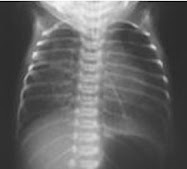Chest pain doesn't always signal a heart attack
Noncardiac causes can include a pulmonary embolism, acid reflux and pinched nerves
Monday, December 15, 2008
Staten Island Advance
STATEN ISLAND, N.Y.
-- During the last week, I had a number of patients with the same complaint --
they feared that they were having a heart attack
because of pain in the lower chest. Happily, none did!
But the fear remained, as they asked,
"How can you be sure?" and "What else could it be?"
Interestingly, these are not completely separate questions and our job today will be to answer them.
Chest pain, like fancy chocolates, comes in many sizes and shapes, and just about every cause of chest pain has its own size and shape.
Heart attack, to answer the most important question first,
causes a tightness or pressure, sometimes fancifully described as if an elephant were standing on the chest.
It begins softly and increases in intensity over several minutes until it is extremely severe.
It lasts at least 15 minutes, and often for hours, and can travel from the central chest up to the jaw and down the left arm, where it is perceived as heaviness.
It is often associated with nausea and vomiting and preceded by no other symptom except, perhaps, unusual tiredness or exhaustion at the end of the day.
This constellation of symptoms is so uniquely characteristic that, in experienced hands, the electrocardiogram is used only to confirm the diagnosis and the blood test (for specific enzymes liberated by the damaged heart muscle) to measure the extent of the heart attack.
So, if it isn't a heart attack, what else can cause chest pain?
The answer is that every organ and structure in the chest can cause pain but each one has its individual mark.
The outside lining of the lungs can become inflamed as a complication of pneumonia in the disorder called "pleurisy."
In this case, sharp, knifelike pain accompanies deep breathing or coughing and is relieved by holding the breath.
This is associated with a fever, shortness of breath and sputum production --
a picture very different from heart attack.
Similarly, the outside lining of the heart can become inflamed in the disorder called "pericarditis."
The same knifelike pains occur in the left chest, particularly when leaning forward, and are not relieved by holding the breath.
This condition is usually preceded by a sore throat and fever and there is no shortness of breath or cough.
Another condition in which the pain mimics heart attack is pulmonary embolism, where a blood clot formed elsewhere in the body travels to the lungs and blocks the blood flow through the lungs.
While the pain is similar, the circumstances provide a clue to the diagnosis. The patients are acutely and severely short of breath and almost always have a recognizable site for the initial formation of a clot. It could be in the calf of the leg, which is painful and swollen, or surgery to the hip or pelvic organs in the preceding week.
Measurement of the oxygen content of the blood confirms the diagnosis and a radioactive lung scan visualizes the site of a clot or clots in the lung arteries.
AORTIC DISSECTION
Another, less common cause of chest pain is dissection of the aorta, where the combination of high blood pressure and the cholesterol plaques in the main artery out of the heart allow blood to strip the inner layer of the artery wall from the outer layer.
This serious condition can interfere with the blood flow to the arms and the brain, and is characterized by the very sudden and immediate severity of the central chest pain.
Patients can remember the exact moment the pain began,
as distinct from all the other pains described above, which begin imperceptibly and increase in intensity over time.
In this instance, the patient may give a story like this,
"I was drying the dishes and was just reaching for the salad bowl when the pain HIT me." or
"The phone rang and I was just lifting the receiver when the pain HIT."
And so on! Some people who experience acid reflux also have chest pain,
which is relieved by antacids.
Fractured ribs cause a sharp pain on breathing, characterized by tenderness over the fracture site, and usually a history of injury to the chest.
In the same manner, arthritis of the spine and nerve compression from ruptured disks in the neck produce characteristic pain patterns with specific associated symptoms,
which provides a unique diagnostic picture.
So when the patient has chest discomfort that does not fit the pattern of a heart attack and when the patient is sufficiently observant and articulate,
a confident and encouraging alternative diagnosis can be proposed without delay or a million-dollar work up.
The story tells it all.
Dr. Dennis Bloomfield is a cardiologist affiliated with Richmond University Medical Center and is president of the Staten Island Heart Society. He is a monthly contributor, along with the Richmond County Medical Society, to this column.
Monday, December 15, 2008
Subscribe to:
Post Comments (Atom)




No comments:
Post a Comment